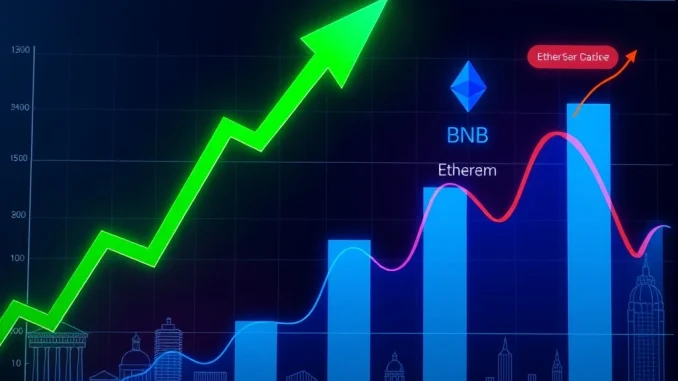
Welcome to a pivotal moment in the crypto world! Today’s Ethereum News brings a fascinating mix of market dynamics, from explosive altcoin growth to significant institutional movements. If you’re keen on understanding where the digital asset landscape is heading, you’re in the right place. We’ll unpack the forces behind BNB’s remarkable ascent, the surge in Ethereum ETF investments, and what these shifts mean for the broader market, including Bitcoin’s recent performance.
BNB Surge: What’s Driving Binance Coin’s Explosive Growth?
The cryptocurrency market on July 1st showcased a truly mixed bag of performances, but one asset undeniably stole the spotlight: BNB. Binance Coin didn’t just perform well; it surged past the $800 mark, establishing a new all-time high and claiming the third-largest market capitalization at over $112 billion. This remarkable BNB Surge represented a significant reversal, as BNB overtook Solana (SOL) to reclaim its position as the third-largest crypto by market cap, a spot Solana had held for several weeks.
What fueled this impressive 22% jump? Analysts point to several key factors:
- Expanding DeFi Utility: BNB’s increasing utility within decentralized finance (DeFi) applications and its role in facilitating cross-chain activities have been crucial. Its ecosystem continues to expand, offering more use cases for the token.
- Investor Confidence: The surge underscores a renewed investor confidence in the Binance ecosystem, viewing BNB as a utility-driven asset with robust fundamentals.
- Institutional Integration: Notably, BNB’s growing role in institutional-grade custody solutions and its integration with legacy banking infrastructure have been highlighted as significant drivers. This signals a maturation of the asset beyond pure speculation.
While competitors like Solana faced profit-taking pressures, BNB’s market cap growth not only solidified its position but also signaled a broader shift in investor sentiment towards assets with tangible utility and institutional appeal.
Crypto ETFs: Ethereum’s Inflow Bonanza vs. Bitcoin’s Outflows
The narrative surrounding Crypto ETFs took an interesting turn this week, highlighting a divergence in investor sentiment between the two largest cryptocurrencies. Ethereum (ETH) experienced robust inflows into its exchange-traded funds, recording a staggering $534 million on a single day. This marked the third-highest single-day inflow for Ethereum ETFs, reflecting a renewed institutional appetite for the blockchain’s post-merge ecosystem.
This influx for Ethereum ETFs is particularly significant as it followed two consecutive days of outflows for Bitcoin ETFs. The shift suggests a change in risk appetite, with investors increasingly favoring Ethereum’s ongoing network upgrades, such as the eagerly anticipated EIP-4844 proposal (Proto-Danksharding), over Bitcoin’s more established but perhaps less innovative trajectory.
However, it’s not all smooth sailing for Ethereum. The network faces immediate challenges, with nearly $2 billion in unstaked ETH poised to become liquid over the next nine days. This substantial unlock could introduce short-term volatility, a factor investors will need to monitor closely.
Here’s a snapshot of the market’s performance:
| Asset | Performance (July 1) | Key Metric |
|---|---|---|
| BNB | +22% | New All-Time High, $112B Market Cap |
| ETH | N/A (focus on ETFs) | $534M ETF Inflows |
| BTC | -0.5% | Net Outflows, $118,500 Price |
| PENGU | +18% | Multi-year high (Meme Coin) |
| REKT | N/A (significant gains) | Multi-year high (Meme Coin) |
| XRP | -2% | Profit-taking/Regulatory uncertainty |
| SOL | -1% | Profit-taking |
Bitcoin Price: A Brief Dip Amidst Broader Market Shifts
While altcoins like BNB and Ethereum grabbed headlines with their positive momentum, Bitcoin Price experienced a slight downturn. The world’s leading cryptocurrency faced net outflows from its ETFs and recorded a 0.5% decline, settling at $118,500. This minor dip, while not alarming, underscored the shifting investor focus and the broader market’s mixed performance.
Bitcoin’s trajectory, often seen as a barometer for the entire crypto market, appears to be consolidating as capital flows into other segments, particularly those with strong development narratives or institutional backing. While Bitcoin remains the cornerstone of the crypto economy, its recent performance suggests that investors are increasingly diversifying their portfolios to capture opportunities in other high-growth areas.
Institutional Crypto Adoption: Bridging the Gap Between TradFi and DeFi
Perhaps one of the most significant takeaways from the week’s developments is the accelerating pace of Institutional Crypto Adoption. Traditional financial giants are not just observing; they are actively integrating crypto infrastructure into their services. A prime example is the partnership between Coinbase and PNC Bank to offer a “Crypto-as-a-Service” model. This collaboration is a game-changer, enabling PNC clients to access crypto custody and trading services directly, while Coinbase clients gain access to banking solutions from a legacy financial institution.
This partnership marks a pivotal step towards mainstream adoption, as traditional banks recognize and respond to growing client demand for digital asset services. Beyond this, we saw major players like Goldman Sachs and Bank of New York Mellon (BNY) announce plans to launch tokenized money market funds. These initiatives position these financial titans as crucial bridges between traditional finance and the burgeoning blockchain technology, signaling a future where digital assets are seamlessly integrated into conventional financial systems.
Regulatory developments also added nuance to the week. Citadel, a major market maker, raised concerns with the SEC, warning that tokenized stocks could potentially siphon liquidity from traditional markets. This highlights the ongoing tension and dialogue between crypto innovators and regulators, as the industry continues to evolve. On a more accessible front, the launch of the Telegram Crypto Wallet for U.S. users further expanded accessibility for in-app trading and payments, building on similar moves like Jack Dorsey’s Square (now Block) allowing merchants to accept Bitcoin directly. These developments reinforce crypto’s growing role in everyday commerce.
Meme Coins: The Speculative Frenzy Continues
Amidst these significant market shifts and institutional advancements, the speculative fervor around meme tokens continued unabated. PENGU and REKT captured retail momentum, hitting multi-year highs. PENGU surged 18% on the day, largely fueled by viral traction on social media platforms and, notably, a lack of fundamental valuation metrics. REKT followed a similar trajectory, driven by narratives linking its tokenomics to broader memecoin market dynamics.
These gains occurred even as broader market sentiment showed weakness for some established altcoins, with XRP and SOL slipping 2-1% due to profit-taking and ongoing regulatory uncertainty. The performance of meme coins serves as a reminder of the dual nature of the crypto market: a space for serious technological innovation and institutional integration, but also one where speculative assets can generate significant short-term excitement driven by community and narrative.
Conclusion: A Maturing Market with Diverse Opportunities
The past week’s developments painted a clear picture of a maturing cryptocurrency market, brimming with diverse opportunities and evolving dynamics. While speculative assets like PENGU and REKT continue to drive short-term excitement and retail engagement, the foundational work for sustainable growth is being laid by institutional-grade projects like BNB and Ethereum. The significant Ethereum News regarding ETF inflows and BNB’s impressive surge underscore a shift in investor focus towards utility and institutional integration.
Challenges certainly remain, particularly concerning regulatory scrutiny and technical headwinds for Ethereum with its upcoming unstaking event. However, the accelerating pace of Institutional Crypto Adoption, evidenced by collaborations between crypto native firms and traditional banks, signals a robust path towards mainstream integration. As the market continues to navigate these complexities, staying informed about these key trends will be crucial for any participant.
Frequently Asked Questions (FAQs)
Q1: Why did BNB surge by 22% this week?
BNB’s 22% surge was primarily driven by its expanding utility within decentralized finance (DeFi) and cross-chain activities, coupled with growing investor confidence in its ecosystem. Analysts also highlighted its role in institutional-grade custody solutions and integration with legacy banking infrastructure as key drivers.
Q2: What do the $534 million Ethereum ETF inflows signify?
The significant $534 million inflows into Ethereum ETFs reflect renewed institutional interest in Ethereum’s post-merge ecosystem and its upcoming network upgrades like EIP-4844. This divergence from Bitcoin ETF outflows suggests a shift in risk appetite, with investors favoring Ethereum’s innovation potential.
Q3: What are the immediate challenges facing Ethereum?
Ethereum faces an immediate challenge with nearly $2 billion in unstaked ETH becoming liquid over the next nine days. This substantial unlock could potentially create short-term volatility in the market as these funds become available for trading.
Q4: How is institutional adoption impacting the crypto market?
Institutional adoption is rapidly bridging the gap between traditional finance and crypto. Partnerships like Coinbase with PNC Bank, and plans by Goldman Sachs and BNY Mellon for tokenized money market funds, are integrating crypto services into mainstream finance, increasing accessibility and legitimacy for digital assets.
Q5: Why did Bitcoin’s price slump while other cryptos surged?
Bitcoin experienced a modest 0.5% decline and net ETF outflows while other cryptos surged. This indicates a shifting investor focus, with capital flowing into altcoins like BNB and Ethereum that are showing strong development narratives or significant institutional interest, leading to a temporary diversification away from Bitcoin.



